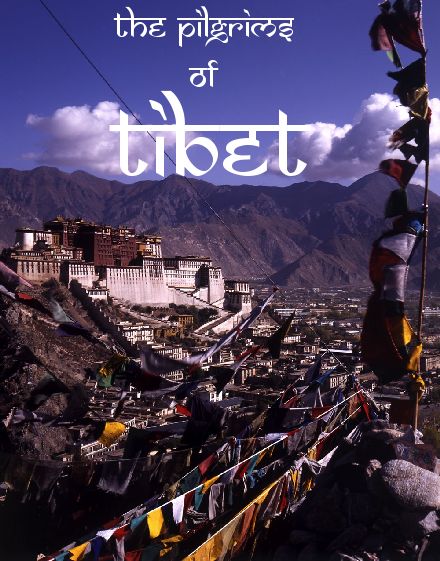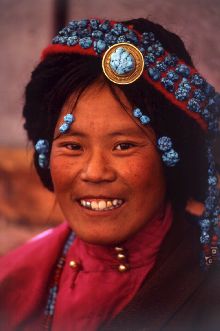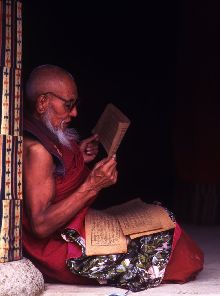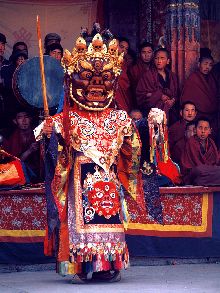 |
Prayer
flags-blue for the sky, white for clouds, green for grass, yellow for the
earth and red for fire-flutter in the wind throughout Tibet, even in the
most remote and uninviting locations. As pilgrims traverse the country
they leave them tied to piles of rocks or strung together flapping from
makeshift flagpoles on high mountain passes, hilltops and chötens
(shrines erected at important religious sites). They believe that as the
wind brushes across the fabric of the flags the prayers written onto them
are transported to heaven bringing merit to the one who puts them in place.
Pilgrimages to the significant
religious sites scattered across the country are central to the lives of
Tibetans. The hardships involved seem incidental. People are prepared to
travel for days on the back of trucks to reach their destinations.
The dust in summer
is choking and during winter the pilgrims endure the bitter cold, biting
winds and freezing temperatures with only their thick yak hair coats to
protect them.
They cross a landscape parched
brown, strewn with rocky rubble and treeless to the horizon. It resembles
an alien place, inhospitable, unprotected, barren and often uninhabited.
In places wild rivers cut
through the moonscape eroding the exposed earth, eating it away and sending
steep hillsides and roadways tumbling into their surging waters.
In other places vehicles
turn the stony bottom of a dry river-bed into a road as they cross a high
plateau but at such an altitude that mountain tops 5 thousand metres high
are at eye level. |
 |
Some roads cross vast plains
that expand into the distance where Himalayan peaks sparkle white below
the deep blue of the high altitude sky, and skirt glaciers-jumbled and
mangled chunks of ice the size of houses-which shimmer blue-green in the
sunlight as they slither, imperceptibly, from mountainsides. Lack of oxygen
brings on headaches and mild nausea for travellers not used to the altitude
even though they are sitting quietly on a bus or the back of a truck. |
 |
The expense of these journeys
can sometimes leave the pilgrims without enough money to get home. Despite
this, thousands are still prepared to undertake the hardships in order
to gain merit, highlighting one of the most significant aspects of Tibetan
life: the devout, and almost universal, adherence to Tibet’s unique branch
of the Buddhist religion.
Travellers arrive in Lhasa
every day to pay homage at the great monasteries, and temples and visit
the red and white washed Potala Palace, once the home of the spiritual
leader of the Tibetan people. |
From early in the morning pilgrims
climb the steep ramp from street-level into the lower courtyard of the
Potala. They shuffle their way up through the massive labyrinth of half
lit halls, shrines and tombs of past Dalai Lamas in a single file, clutching
the coat of the person in front. Inching down narrow, dark corridors, past
exquisite images of Buddhist deities, up ancient wooden staircases and
into cavernous rooms barely lit by yak butter lamps, pilgrims slowly make
their way to the roof where they are afforded a panoramic view across Lhasa
and the surrounding countryside. |
Young
monks work hard to gain as much knowledge as they can in order to progress
through the various levels of understanding.
 |
During
debates held in monasteries across Tibet the monks are tested by their
peers in a frenzied question and answer session that goes on for several
hours.
Surrounded by his colleagues,
question after question is thrown at the young monk. His responses are
met with a shout, a stamp of the questioners foot and an aggressive, single
hand clap over the initiates head signifying if the answer is correct.
The teachers at the monasteries instruct the questioners to "stamp your
feet so hard that the door of hell will be broken open and clap your hands
so loud that the voice of knowledge will frighten the devils all over the
world." |
The twenty-first century arrives
slowly in Tibet. The first motorised transport did not arrive until the
1950's and Buddhist scriptures are still printed one page at a time from
wooden printing blocks. In some senses not much has changed from the days
when pilgrims might have ridden their horses or even walked across Tibet
in their quest to hear for themselves ‘the voice of knowledge’. |
 |
PLEASE NOTE:
A wide range of original photographic essays are available for publication and are generally accompanied by a minimum of between 60-80 high quality images shot in high resolution 35mm digital format.
Editors may suggest specific story concepts related to the current schedule of the photographer with no obligation as to the eventual purchase of the material produced.
Barrie Brown Photography
Email: barrie@barriebrown.com
Copyright B. Brown 1999-. All images and text shown here are the exclusive property of Barrie Brown and may not be used, stored, reproduced or redistributed without the express written permission of Barrie Brown or his assigns. |
|




